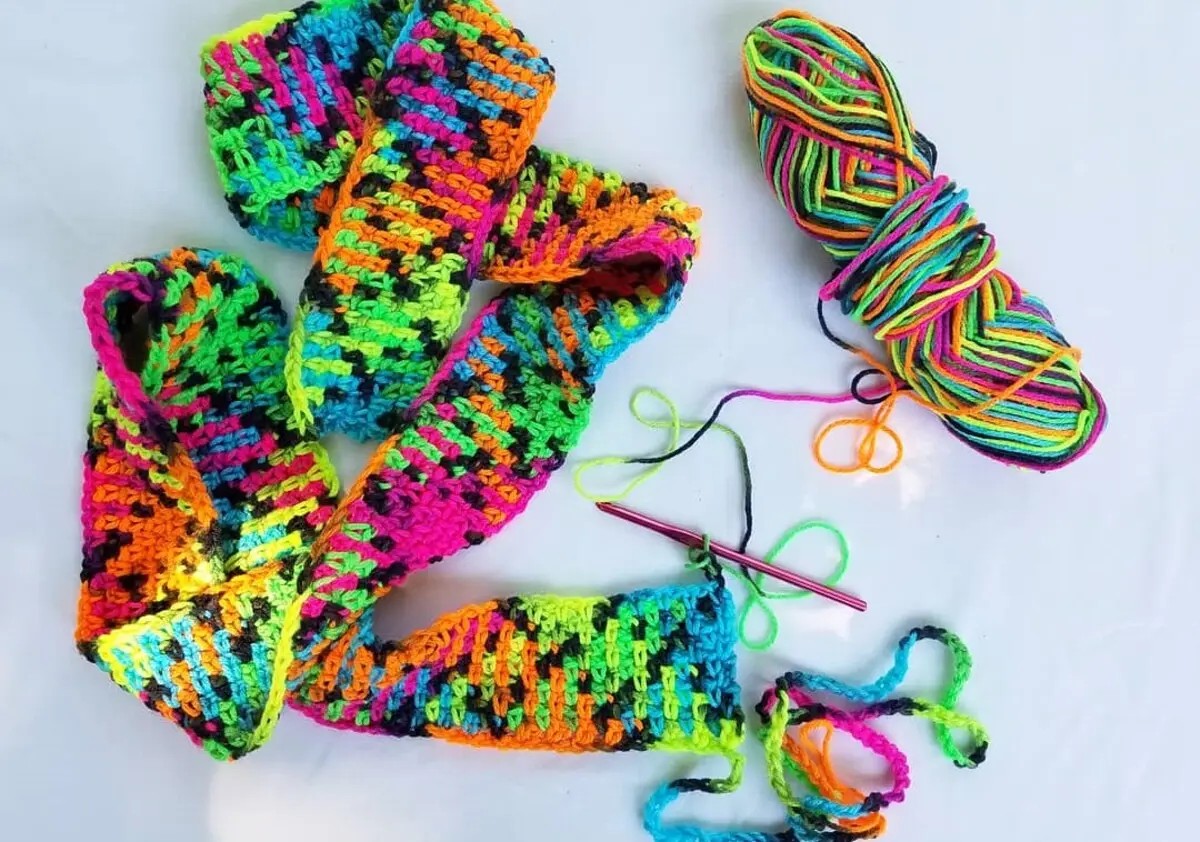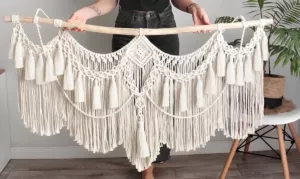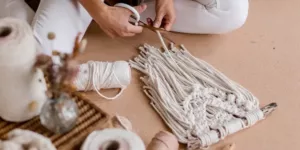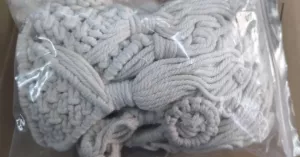Variegated macrame yarn crochet pooling can turn your dream project into a frustrating nightmare, creating unwanted blotches and uneven color distribution that ruin the visual appeal of your carefully planned designs. This common challenge affects countless crafters worldwide, leaving them with projects that look amateur despite their best efforts and quality materials.
Understanding how to prevent color pooling in variegated yarn transforms your macrame experience from guesswork into confident artistry. When you master these techniques, your projects showcase beautiful, evenly distributed colors that flow naturally throughout your work, creating professional-looking pieces that impress viewers and satisfy your creative vision.
The global craft market continues expanding rapidly, with macrame specifically experiencing a renaissance among modern makers. However, many artisans struggle with variegated macrame yarn crochet pooling issues that prevent them from achieving their desired results. This comprehensive guide addresses these challenges head-on, providing proven solutions that experienced crafters use to create stunning, pool-free projects consistently.
Understanding Variegated Macrame Yarn Crochet Pooling
What Causes Color Pooling
Color pooling occurs when variegated yarn’s color sequences align in ways that create concentrated patches of single colors rather than evenly distributed variations throughout your macrame project. This phenomenon happens because most commercial variegated yarns follow predictable color patterns with consistent sequence lengths that, when worked in regular macrame patterns, create unwanted clustering effects.
The mathematical relationship between your yarn’s color repeat length and your project’s stitch count determines whether variegated macrame yarn crochet pooling will occur. When these measurements align unfavorably, colors stack upon each other instead of distributing randomly, creating the telltale blotchy appearance that frustrates crafters.
Understanding your specific yarn’s color sequence becomes crucial for prevention strategies. Different manufacturers use varying repeat lengths, from short 12-inch sequences to longer 36-inch patterns. Recognizing these patterns before beginning your project allows you to implement appropriate prevention techniques.
Identifying Pooling-Prone Yarns
Not all variegated yarns create pooling issues equally. Short-repeat variegated yarns with high contrast between colors tend to pool more dramatically than those with longer sequences and subtle color transitions. Examining your yarn’s color pattern before starting helps predict potential variegated macrame yarn crochet pooling problems.
Yarns with abrupt color changes create more noticeable pools than those with gradual transitions. When shopping for variegated materials, look for options with longer color segments and smoother transitions between hues. These characteristics naturally resist pooling and create more pleasing random color distribution.
Testing small swatches before committing to full projects reveals how specific yarns behave with your chosen techniques. This investment of time and materials prevents disappointment and waste while teaching you how different yarn characteristics affect your finished results.
Essential Prevention Strategies
Strategy 1: Strategic Yarn Management
Effective yarn management forms the foundation of successful variegated macrame yarn crochet pooling prevention. Working with multiple skeins simultaneously disrupts predictable color patterns by introducing random variations that break up potential pooling formations. Purchase at least two skeins of your chosen variegated yarn for most projects.
Alternating between skeins every few rows or sections creates natural color disruption that prevents systematic pooling. This technique works particularly well for large wall hangings and plant holders where consistent color distribution enhances overall visual appeal. Mark your working position in each skein to maintain organized rotation.
Some experienced crafters take this approach further by working with three or even four skeins simultaneously, switching between them using random patterns rather than systematic rotation. This method creates completely unpredictable color placement that virtually eliminates variegated macrame yarn crochet pooling while maintaining visual coherence.
Strategy 2: Pattern Modification Techniques
Modifying your macrame patterns disrupts the mathematical relationships that cause color pooling. Varying your knot spacing, changing cord lengths between anchor points, or incorporating irregular pattern elements breaks up predictable color sequences that lead to pooling problems.
Traditional macrame patterns often use consistent measurements that inadvertently promote pooling in variegated yarns. Introducing controlled variations in these measurements while maintaining overall pattern integrity prevents color clustering without compromising your design’s structural integrity or visual appeal.
Advanced pattern modification involves analyzing your yarn’s color repeat length and deliberately designing your macrame pattern to avoid mathematical relationships that encourage pooling. This approach requires more planning but produces consistently excellent results for variegated macrame yarn crochet pooling prevention.
Strategy 3: Tension Control Methods
Inconsistent tension naturally disrupts color sequences by varying the amount of yarn consumed in each section of your project. While maintaining overall structural integrity, slight tension variations prevent the uniform consumption patterns that promote color pooling in variegated yarns.
Experienced crafters intentionally introduce subtle tension changes throughout their projects to break up color patterns. These variations remain small enough to avoid affecting the finished piece’s appearance while significantly reducing variegated macrame yarn crochet pooling tendencies.
Combining tension control with other prevention strategies amplifies their effectiveness. When used alongside yarn management and pattern modifications, controlled tension variations create multiple layers of color disruption that virtually guarantee pool-free results in your finished projects.
Strategy 4: Color Interruption Techniques
Strategic color interruption involves temporarily switching to solid-colored yarns or different variegated patterns to break up potential pooling formations. This technique works exceptionally well for projects where accent colors enhance the overall design while serving practical pooling prevention purposes.
Incorporating solid-colored sections every few inches disrupts variegated color sequences completely, resetting the pattern for continued random distribution. Choose accent colors that complement your variegated yarn’s palette for seamless integration that looks intentional rather than corrective.
Some crafters use multiple variegated yarns with different color sequences worked together to create complex color interactions that resist pooling while producing unique visual effects impossible to achieve with single yarns. This advanced variegated macrame yarn crochet pooling prevention method requires careful color coordination but produces stunning results.
Strategy 5: Advanced Planning and Mapping
Pre-project planning and color mapping prevent pooling issues before they develop by analyzing yarn behavior and designing appropriate countermeasures. Creating small test samples reveals how your chosen yarn behaves with specific techniques, allowing adjustments before investing time in full projects.
Document successful prevention strategies for different yarn types and project styles to build a personal reference library. This knowledge base accelerates future project planning while ensuring consistent results across various variegated macrame yarn crochet pooling prevention applications.
Digital planning tools help visualize potential pooling patterns and test prevention strategies virtually before beginning actual work. Photography editing software can simulate different color arrangements and help identify problematic areas before they occur in your physical project.
Yarn Selection and Preparation
Choosing Pool-Resistant Variegated Yarns
Selecting appropriate yarns significantly reduces variegated macrame yarn crochet pooling challenges from the outset. Look for variegated options with longer color repeats, typically 18 inches or more, as these naturally resist pooling better than shorter-repeat alternatives. Longer sequences provide more opportunities for random color distribution throughout typical project sizes.
Yarns with gradual color transitions create less dramatic pooling when it does occur, making any remaining color clustering less visually problematic. Avoid high-contrast variegated yarns for your first pooling prevention attempts, as these create the most noticeable pooling effects when prevention strategies fail.
Consider the relationship between your yarn’s color repeat length and your planned project dimensions. Projects significantly larger than the yarn’s repeat length naturally resist pooling, while those similar in size to the repeat pattern are most susceptible to clustering problems.
Pre-Treatment and Preparation Methods
Proper yarn preparation enhances pooling prevention efforts by ensuring consistent handling characteristics throughout your project. Pre-washing variegated yarns removes manufacturing residues that can affect yarn behavior and reveals true color intensity after processing.
Some crafters pre-stretch their variegated yarns slightly to even out any tension irregularities introduced during the dyeing process. This technique ensures consistent yarn behavior throughout the project, reducing one variable that can contribute to unpredictable color distribution patterns.
Organizing your yarn preparation workspace efficiently speeds project completion while reducing errors that can compromise variegated macrame yarn crochet pooling prevention efforts. Keep tools and materials organized and easily accessible to maintain focus on proper technique execution.
Advanced Techniques and Solutions
Professional Color Management Systems
Professional-level color management involves systematic approaches to yarn handling that guarantee consistent results across multiple projects. Developing standardized procedures for yarn rotation, tension control, and pattern modifications creates repeatable success with variegated macrame yarn crochet pooling prevention.
Color coding your yarn skeins helps track rotation patterns and ensures even usage across multiple balls. Simple marking systems using colored tape or tags prevent confusion during complex projects while maintaining organized workflow patterns that support consistent prevention results.
Documentation systems that track successful prevention strategies for specific yarn types accelerate future project planning. Recording details about yarn characteristics, effective techniques, and project outcomes builds valuable reference materials for continued improvement in pooling prevention skills.
Troubleshooting Existing Pooling Issues
When pooling problems develop despite prevention efforts, several corrective strategies can salvage projects without complete restart. Strategic yarn replacement in problem areas often resolves minor pooling without affecting overall project integrity or appearance.
Color blending techniques using additional yarn strands can disguise existing pools by introducing complementary colors that break up concentrated areas. This approach requires careful color matching but can transform problematic sections into intentional design elements.
Advanced troubleshooting involves analyzing why prevention strategies failed in specific situations, providing learning opportunities that improve future variegated macrame yarn crochet pooling prevention success. Understanding failure modes helps refine techniques and develop more robust prevention systems.
Project-Specific Applications
Wall Hangings and Large Projects
Large macrame wall hangings present unique challenges for variegated macrame yarn crochet pooling prevention due to their size and complexity. The extended working time increases opportunities for color patterns to establish and create clustering problems if not managed properly throughout the construction process.
Breaking large projects into manageable sections allows for better color control while maintaining overall design integrity. Working in horizontal bands or vertical sections permits yarn rotation and pattern adjustments without compromising the finished piece’s structural or visual coherence.
Planning color placement for large projects requires consideration of viewing distance and lighting conditions where the finished piece will be displayed. Colors that might pool noticeably at close range often blend acceptably when viewed from normal room distances.
Plant Holders and Functional Items
Functional macrame items like plant holders require structural integrity that can conflict with some pooling prevention techniques. Balancing color management with strength requirements demands careful technique selection and adaptation to maintain both visual appeal and practical durability.
Three-dimensional projects create different color viewing angles that can minimize pooling visibility while highlighting other color aspects. Understanding how your project will be viewed and used influences the importance of various prevention strategies and helps prioritize technique selection.
Weight-bearing elements in functional pieces may require consistent yarn characteristics that limit some prevention options. Identifying critical structural areas allows focused attention on essential strength requirements while permitting color management flexibility in decorative sections.
Small Decorative Pieces
Small projects present concentrated opportunities for variegated macrame yarn crochet pooling problems because the entire piece may span only one or two color repeats. These projects often benefit most from yarn selection strategies rather than complex pattern modifications or rotation techniques.
Accent integration works particularly well in small pieces where additional colors enhance rather than complicate the overall design. Strategic color placement can transform potential pooling problems into intentional design features that add visual interest and sophistication.
Quick completion times for small projects allow experimentation with different prevention techniques without major time investments. Use these opportunities to test strategies and build skills that transfer to larger, more complex projects.
Maintenance and Long-Term Success
Developing Consistent Techniques
Building muscle memory for effective variegated macrame yarn crochet pooling prevention requires consistent practice and technique refinement. Regular application of prevention strategies across various projects develops intuitive understanding of color behavior and automatic implementation of appropriate countermeasures.
Maintaining detailed project notes accelerates skill development by documenting what works and what doesn’t for different situations. These records become invaluable references for future projects and help identify patterns in successful prevention strategies across different yarn types and project styles.
Continuous technique improvement involves staying current with new prevention methods and adapting successful strategies to new project types. The macrame community regularly develops innovative solutions that enhance traditional prevention approaches.
Quality Control and Assessment
Regular quality assessment throughout project construction allows early detection and correction of developing pooling problems. Stepping back frequently to evaluate color distribution patterns enables timely interventions before problems become difficult to address.
Photographic documentation of projects in various lighting conditions reveals how color distributions appear under different circumstances. This information guides lighting considerations for display locations and helps evaluate the success of prevention strategies.
Seeking feedback from other crafters provides external perspectives on color distribution success and identifies areas for improvement that might not be apparent to the creator. Online communities offer valuable resources for sharing experiences and learning from others’ successes and challenges.

1 pc 5-strand rainbow cotton yarn ball
Rainbow Cotton Yarn Ball—a perfect blend of quality and color for your next DIY project. Whether you’re knitting, crocheting, or embarking on any woven venture, this mesmerizing yarn will bring your creations to life with its stunning spectrum of hues and soft, sumptuous texture.
Frequently Asked Questions
Why does my variegated yarn always create color pools despite following prevention techniques?
Color pooling persistence often indicates mismatched prevention strategies for your specific yarn characteristics. Different variegated yarns require different approaches based on their color repeat length, contrast levels, and fiber composition. Analyze your yarn’s specific color pattern length and adjust your prevention techniques accordingly. Short-repeat, high-contrast yarns need more aggressive intervention than longer-repeat, subtle variations. Consider switching to yarns with longer color sequences or lower contrast levels if pooling continues to be problematic with your current selection.
Can I fix color pooling after completing my macrame project?
Limited correction options exist for finished pieces with variegated macrame yarn crochet pooling issues, but some strategies can improve appearance without complete reconstruction. Surface embellishments using complementary solid colors can disguise pooled areas by breaking up concentrated color zones. Strategic placement of decorative elements like beads, tassels, or woven accent pieces draws attention away from problematic areas. However, prevention remains far more effective than correction, making proper planning and technique implementation essential for satisfactory results.
Which yarn brands offer the best variegated options for pooling prevention?
Several manufacturers produce variegated yarns specifically designed to resist pooling through longer color repeats and gradual transitions. Look for brands advertising “anti-pooling” or “random dye” techniques in their variegated lines. These yarns typically feature 24-inch or longer color sequences with subtle transitions that naturally distribute colors evenly. However, success depends more on matching yarn characteristics to your project requirements and implementing appropriate prevention techniques than on specific brand selection.
How do I know if my project will have pooling problems before starting?
Pre-project testing reveals potential variegated macrame yarn crochet pooling issues before investing time in full-scale construction. Create small swatches using your planned techniques and yarn to observe color behavior patterns. Measure your yarn’s color repeat length and compare it to your project’s dimensions and stitch patterns. Mathematical relationships between these measurements predict pooling likelihood. Projects with dimensions that are multiples of the color repeat length are most susceptible to pooling problems and require aggressive prevention strategies.
Conclusion
Successfully preventing variegated macrame yarn crochet pooling transforms frustrating craft sessions into confident creative experiences that produce professional-quality results consistently. The five proven strategies outlined in this guide provide comprehensive solutions for crafters at every skill level, from strategic yarn management and pattern modifications to advanced planning and troubleshooting techniques.
Mastering these prevention methods requires practice and patience, but the investment pays dividends in improved project outcomes and increased crafting satisfaction. By understanding color behavior, implementing appropriate prevention strategies, and maintaining consistent techniques, you can confidently tackle any variegated yarn project knowing that pooling problems won’t compromise your creative vision or waste your valuable time and materials.









